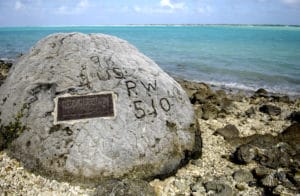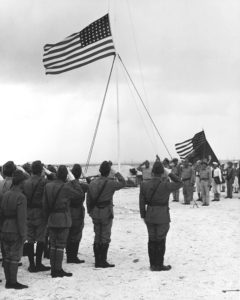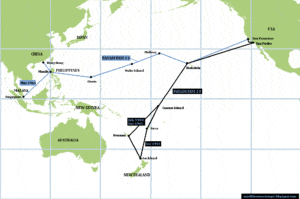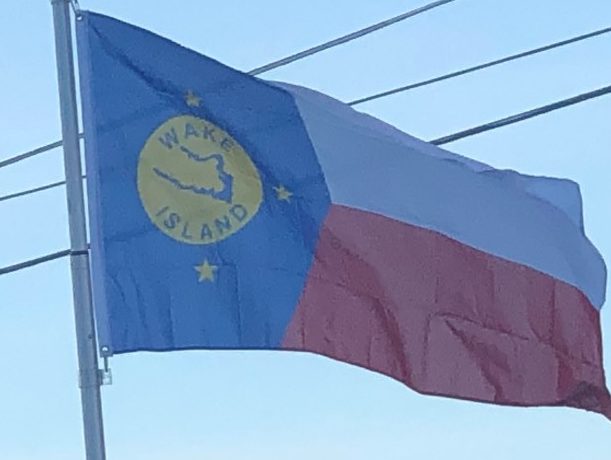After a successful American air raid on October 5, 1943, Sakaibara ordered the execution of all of the 98 captured Americans who remained on the island. They were taken to the northern end of the island, blindfolded and machine-gunned. One prisoner escaped, carving the message “98 US PW 5-10-43” on a large coral rock near where the victims had been hastily buried in a mass grave. This unknown American was soon recaptured and beheaded.

Sakaibara and his subordinate, Lt. Cmdr. Tachibana, were later sentenced to death after conviction for this and other war crimes. Tachibana’s sentence was later commuted to life in prison. Sakaibara was executed on June 18, 1947, on Guam. The remains of the murdered civilians were exhumed and reburied at the National Memorial Cemetery of the Pacific in section G.
On September 4, 1945, the Japanese garrison surrendered to a detachment of United States Marines under the command of Brig. Gen. Lawson H. M. Sanderson.

At that point the garrison had been almost cut off from supplies since the 1943 air raids, and was reduced to the point of starvation. While the islands’ sooty tern colony had received some protection as a source of eggs, the Wake Island rail was hunted to extinction by the starving soldiers. Ultimately about three-quarters of the Japanese garrison perished, and the rest survived only by eating tern eggs, the Pacific rats introduced by prehistoric voyagers, and what scant amount of vegetables they could grow in makeshift gardens among the coral rubble.
Post-World War II Military and Commercial Airfield:
With the end of hostilities with Japan and the increase in international air travel driven in part by wartime advances in aeronautics, Wake Island became a critical mid-Pacific base for the servicing and refueling of military and commercial aircraft. The United States Navy resumed control of the island, and in October 1945 400 Seabees from the 85th Naval Construction Battalion arrived at Wake to clear the island of the effects of the war and to build basic facilities for a Naval Air Base. The base was completed in March 1946 and on September 24, regular commercial passenger service was resumed by Pan American Airways (Pan Am).

The era of the flying boats was nearly over, so Pan Am switched to longer-range, faster and more profitable airplanes that could land on Wake’s new coral runway. Other airlines that established transpacific routes through Wake included British Overseas Airways Corporation (BOAC), Philippine Airlines and Transocean Airlines. Due to the substantial increase in the number of commercial flights, on July 1, 1947, the Navy transferred administration, operations and maintenance of the facilities at Wake to the Civil Aeronautics Administration (CAA). In 1949, the CAA upgraded the runway by paving over the coral surface and extending its length to 7,000 feet.
Korean War:
In June 1950, the Korean War began with the United States leading United Nations forces against North Korea. In July, the Korean Airlift was started and the Military Air Transport Service (MATS) used the airfield and facilities at Wake as a key mid-Pacific refueling stop for its mission of transporting men and supplies to the Korean front. By September, 120 military aircraft were landing at Wake per day. On October 15, U.S. President Harry S. Truman and Gen. Douglas MacArthur met at the Wake Island Conference to discuss progress and war strategy for the Korean Peninsula. They chose to meet at Wake Island because of its close proximity to Korea so that MacArthur would not have to be away from the troops in the field for long. During 1953, the last year of the war, more than 85% of the air traffic through Wake was military aircraft or civilian contract carriers supporting the Korean War effort.
Tanker Shipwreck and Oil Spill:
On September 6, 1967, Standard Oil of California‘s 18,000-ton tanker SS R.C. Stoner was driven onto the reef at Wake Island by a strong southwesterly wind after the ship failed to moor to the two buoys near the harbor entrance.
